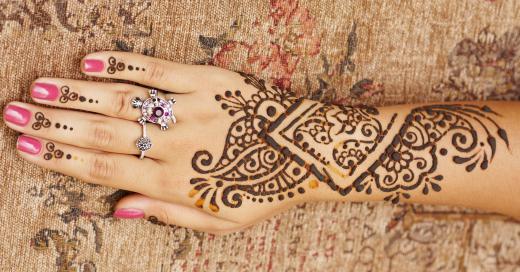At BeautyAnswered, we're committed to delivering accurate, trustworthy information. Our expert-authored content is rigorously fact-checked and sourced from credible authorities. Discover how we uphold the highest standards in providing you with reliable knowledge.
What Are the Different Ways to Use Henna?
The leaves of the henna plant, also known as the mignonette tree or shrub, have been ground and used to add color to the human body and other materials for thousands of years. One of the most common ways to use henna is as a dye for leather and fabric, although it is perhaps best known for its use in temporary body art. In addition to these, it can also act as a natural hair dye, giving nearly any color a reddish tinge.
For centuries, henna has been used to dye leather as well as a variety of fabrics. The ground leaves of the plant are mixed with other ingredients and used to impart a red color to the fabric by either staining the cloth with a paste or dipping it into a hot, liquid mixture of henna. People also often use henna to create designs on leather, especially drum heads and other instruments that contain animal hides. In addition to the unique color that henna can add to these items, it also helps to protect them from weathering and decay by acting as a preservative.

One of the most well-known ways to use henna is for body art, which is most commonly referred to as mehndi. The ground leaves are mixed with water to form a paste and then applied to the skin in intricate patterns. Once wiped off, the paste leaves behind a stain, creating a temporary tattoo that lasts for around a month. In most cultures, especially in India where this use of henna is very popular, the hands, including the nails, are the most common part of the body to use henna in this manner. Despite this, it can generally be done anywhere on the body, and is popular in European countries in creating temporary, customizable tattoos.

This plant is one of the oldest-known means of dying human hair, and has been used to impart a reddish tint to even the darkest locks for centuries. The ground leaves are dissolved in hot water, the dye is applied to the hair, and then it is allowed to sit for several hours before being rinsed out. Commercially, henna is often sold pre-ground and formed into a block, allowing an individual to use henna by grating off a portion of the block before adding it to hot water to make a natural hair dye. The actual shade of red that this creates depends on how much is used, where the henna was grown, and how long it is left on the hair.
AS FEATURED ON:
AS FEATURED ON:














Discussion Comments
Getting a henna tattoo is the thing to do when one goes to the beach. Most of the tattoo parlors also offer henna tattoos. But be careful: some people are allergic to henna and don't know it. Getting a henna tattoo in that case can cause a fairly unpleasant skin reaction that includes redness, swelling and intense itching. Benadryl can help with the symptoms, but it might be wise to do a small skin test first, to see if the person is sensitive to anything in the henna. I know people who got a henna tattoo at the beach and they had reactions to it. They usually go away as the henna fades, but that can take a while, and it isn't fun.
Post your comments